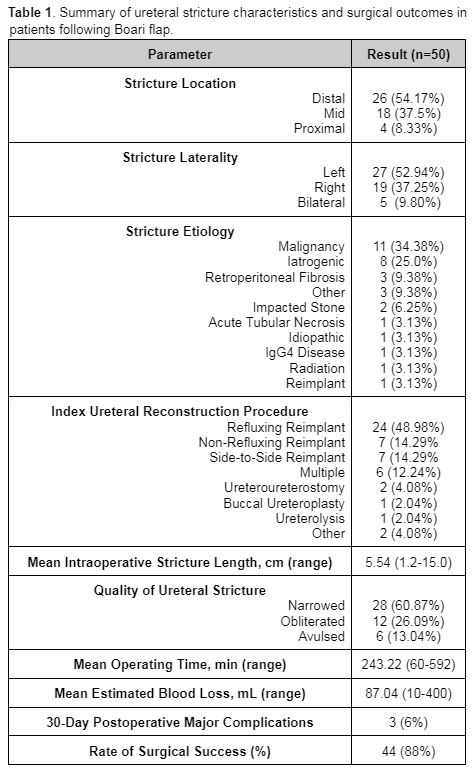Back
Poster, Podium & Video Sessions
Moderated Poster
MP25: Trauma/Reconstruction/Diversion: Ureter (including Pyeloplasty) and Bladder Reconstruction (including fistula), Augmentation, Substitution, Diversion
MP25-14: A Multi-Institutional Experience Utilizing Boari Flap In Robotic Urinary Reconstruction
Saturday, May 14, 2022
10:30 AM – 11:45 AM
Location: Room 228
Kunj Jain, Kevin Alter, Nathan Cheng, Hackensack, NJ, Tanner Corse*, Nutley, NJ, Naveen Krishnan, Matthew Lee, Randall Lee, Philadelphia, PA, Kirtishri Mishra, New York, NY, David Strauss, Daniel Eun, Philadelphia, PA, Lee Zhao, New York, NY, Michael Stifelman, Nutley, NJ

Tanner Corse, BS
Hackensack University Medical Center
Poster Presenter(s)
Introduction: There is currently scarce literature describing outcomes of patients undergoing a Boari flap for ureteral reconstruction. We report our multi-institutional comprehensive experience using Boari flap as an adjunct procedure in patients undergoing robotic ureteral reconstruction (RUR).
Methods: We reviewed our prospective, multi-center Collaborative of Reconstructive Robotic Ureteral Surgery (CORRUS) database for all patients undergoing RUR between September 2013 and September 2021 in which a Boari flap was utilized as an adjunct procedure for ureteral reimplantation. Demographic and operative outcomes were described. Major complications were defined as a Clavien-Dindo Classification Grade > 2. Surgical failure was defined as the presence of flank pain from ureteral obstruction, definitive obstruction on imaging, need for additional procedures with indwelling hardware, need for chronic stenting, repeated ureteral reconstruction, or are currently with hardware despite RUR intervention.
Results: 50 patients underwent RUR with the Boari flap technique (Table 1). The most common stricture etiologies were malignancy (22%) and iatrogenic (16%), with the mean estimated stricture length being 5.54 cm. Strictures were documented as being either narrowed (46%), obliterated (24%), or avulsed (12%), and were most commonly located at the distal (52%) or mid (37.5%) ureter. Of the robotic Boari flaps, 30 were refluxing (60%) and 7 non-refluxing (14%) ureteral reimplants.
The mean operating time was 243.22 min and mean estimated blood loss was 87.04 mL. The mean postoperative length of stay was 2.66 days. 3 patients (6%) experienced major complications in the 30 day postoperative period, with one grade IIIa (urine leak required drainage via interventional radiology [IR]) and two grade IIIb (IR embolization of pseudoaneurysm, colovesical fistula repaired with clip). The mean postoperative follow up was 16.28 months with an 88% (44/50) success rate. The 6 documented cases of failure occurred at an average of 2.52 months following RUR.
Conclusions: Boari flap is a versatile adjunct procedure for patients requiring ureteral reimplantation with minimal complications and high success rate in experienced centers with all observed failures occurring within 3 months of procedure.
Source of Funding: None

Methods: We reviewed our prospective, multi-center Collaborative of Reconstructive Robotic Ureteral Surgery (CORRUS) database for all patients undergoing RUR between September 2013 and September 2021 in which a Boari flap was utilized as an adjunct procedure for ureteral reimplantation. Demographic and operative outcomes were described. Major complications were defined as a Clavien-Dindo Classification Grade > 2. Surgical failure was defined as the presence of flank pain from ureteral obstruction, definitive obstruction on imaging, need for additional procedures with indwelling hardware, need for chronic stenting, repeated ureteral reconstruction, or are currently with hardware despite RUR intervention.
Results: 50 patients underwent RUR with the Boari flap technique (Table 1). The most common stricture etiologies were malignancy (22%) and iatrogenic (16%), with the mean estimated stricture length being 5.54 cm. Strictures were documented as being either narrowed (46%), obliterated (24%), or avulsed (12%), and were most commonly located at the distal (52%) or mid (37.5%) ureter. Of the robotic Boari flaps, 30 were refluxing (60%) and 7 non-refluxing (14%) ureteral reimplants.
The mean operating time was 243.22 min and mean estimated blood loss was 87.04 mL. The mean postoperative length of stay was 2.66 days. 3 patients (6%) experienced major complications in the 30 day postoperative period, with one grade IIIa (urine leak required drainage via interventional radiology [IR]) and two grade IIIb (IR embolization of pseudoaneurysm, colovesical fistula repaired with clip). The mean postoperative follow up was 16.28 months with an 88% (44/50) success rate. The 6 documented cases of failure occurred at an average of 2.52 months following RUR.
Conclusions: Boari flap is a versatile adjunct procedure for patients requiring ureteral reimplantation with minimal complications and high success rate in experienced centers with all observed failures occurring within 3 months of procedure.
Source of Funding: None

.jpg)
.jpg)